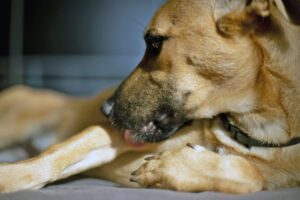Healing stages of a hot spot start with when the hot spot is found on your dog’s coat. With treatment, a hot spot will be completely healed in about five days to two weeks. Hair growing back in over the spot can take several weeks longer. A hot spot—technically, acute moist dermatitis—occurs when your dog becomes obsessed with a sore or itchy or otherwise bothersome spot on his body and continually licks, scratches, and chews at it. The area becomes more painful, the more the dog licks and chews at it and infection is likely to set in.
If your dog develops a hot spot and you are lucky, the stages of healing are:
- Hot spot discovered (day 1)
- Treatment begins (day 1)
- Daily improvement (day 2 through 5 to 14 depending on size and depth of hot spot)
- Completely healed (day 5 to 14 depending on size and depth of hot spot)
- Hair grows back (this can take several weeks after healing)
If your dog develops a hot spot and you are unlucky, the stages of healing are more drawn out:
- Hot spot discovered (day 1)
- Treatment begins (day 1)
- Hot spot worsens (day 2 to 4 depending on how long it takes you to get to the vet)
- Treatment plan adjusted by your veterinarian (day 2 to 4)
- Daily improvement (day 3 through day 7 to day 20, depending on size and depth of hot spot)
- Completely healed (day 7 to 20, depending on size and depth of hot spot)
- Hair grows back (this can take several weeks after healing)
What hot spot stages look like:
- Discovery: You will usually see a moist discharge in the hair surrounding the hot spot. There may be odor. The hot spot itself is red, raw, and oozing. You will notice your dog paying special attention to the area.
- Improvement: Every day the lesion appears a little drier, a little less red and irritated, more of a healthy pink, and your dog is less bothered by it. Eventually a scab may form, especially with deeper lesions. The scab will eventually fall off once skin is healed underneath.
- Completely healed: The skin will look normal, although hairless, and the dog will not be bothered by it.
If you find the hot spot early and want to try a home treatment first, follow these important tips:
- Trim the hair. If your dog will tolerate it, trim or shave the hair over the hot spot and the surrounding hair. This allows for better visualization, more effective topical treatment, and better airflow to the wound.
- Use an antiseptic. Cleanse the wound with a wound cleanser containing an antiseptic like chlorhexidine. Rinse with warm water or saline and pat dry. Apply topical antibacterial ointment like bacitracin or triple antibiotic ointment and topical cortisone cream twice a day. An anti-inflammatory agent like cortisone is often necessary to break the vicious flame-itch-lick-scratch cycle. For those who prefer a more natural approach, topical apple cider vinegar is a decent anti-inflammatory agent and topical coconut oil has antimicrobial properties.
- Cleanse the wound daily. Gently clean the wound every day with saline before applying topical treatments, removing all seepage and residual ointment from the day before. Be sure no discharge is allowed to dry onto surrounding skin or hair as this will cause further irritation.
- Stop the licking. It is imperative that your dog not lick or scratch the hot spot! You must do whatever it takes or you will not win this war. Ongoing licking and/or scratching defeats treatment. Stopping your dog from getting access to the hot spot depends on where the hot spot is. Sometimes an Elizabethan collar or neck donut will work. Sometimes you can have the dog wear a clean, lightweight cotton T-shirt that you change daily. Adding a sock on the hind foot on the side of the hot spot can sometimes be helpful. Be creative. This step is critical.
If you are trying to treat your dog’s hot spot and it is getting worse instead of better, get to the veterinarian as soon as possible. Infected hot spots often require treatment with systemic antibiotics, not just topical. For some dogs, the inflammation and pain associated with the hot spot is so severe, it necessitates the use of oral steroids to break that nasty flame-itch-lick-scratch cycle.
Additionally, some dogs require sedation to get the area properly shaved and cleansed. Finally, bear in mind that your dog’s hot spot happened for a reason. Having your veterinarian diagnose and treat any underlying issues like allergies, ear infections, or flea infestation is imperative for successful healing of the current hot spot and prevention of future ones.







On occasion my Roxy, a Chow/Golden mix, will lick a spot on the top of a front paw causing inflammation. After cleaning it I wrap her foot in self-adhesive wrap. I am fortunate in that she accepts the wrap and doesn’t try to pull it off. I clean her foot daily, apply vaseline and re-wrap. After a couple of weeks, it’s healed up and she forgets about it.